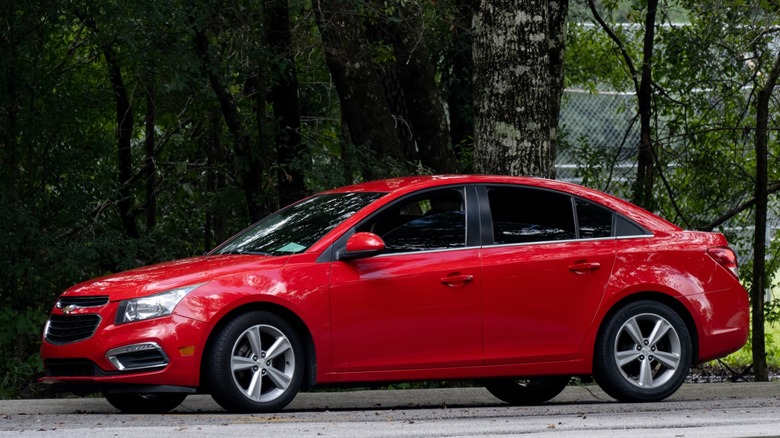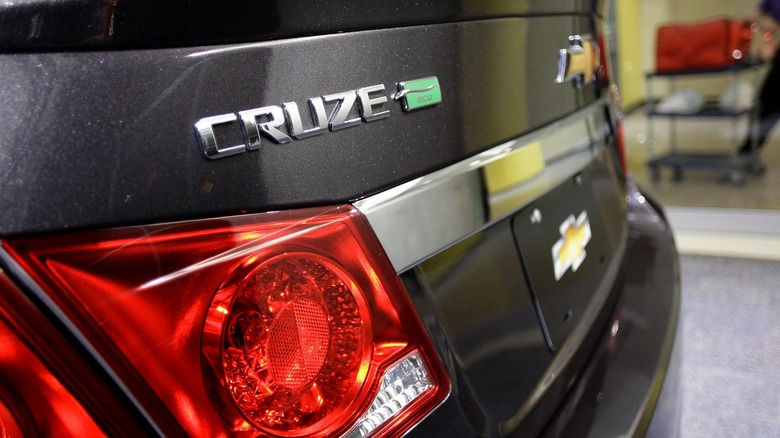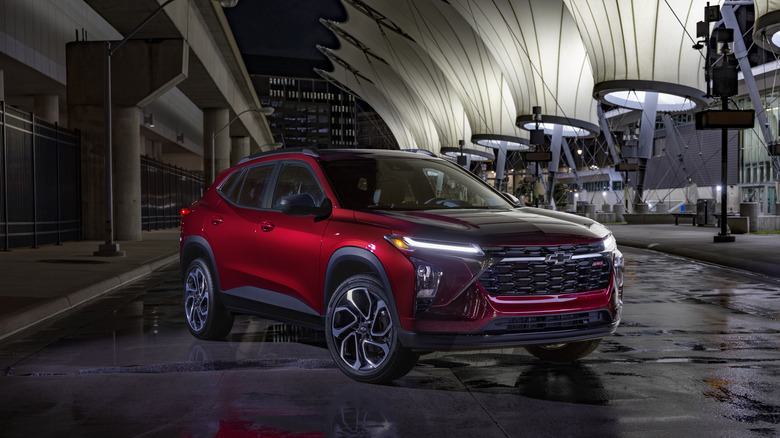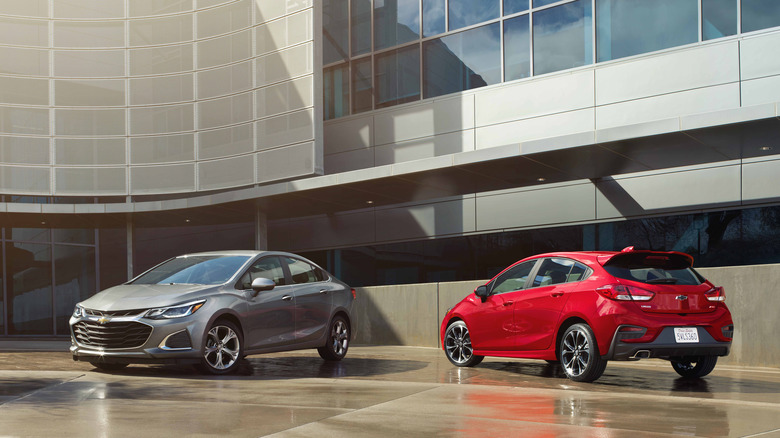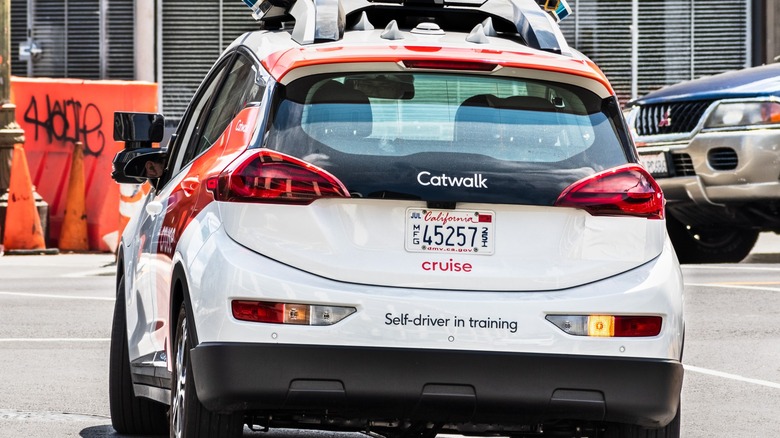The Reason Why Chevrolet Discontinued The Cruze
In 2019, General Motors decided to discontinue the Chevy Cruze, the very same car Edmunds Inside Line had called the company's "most significant car ever." At the car's launch in 2010, even the General Motors' president of North American operations, Mark Reuss, said that the Cruze meant everything to the company.
But let's go back to the beginning and try to understand what made the Cruze so special. General Motors hit rock bottom and filed for bankruptcy on June 1, 2009. However, the company pulled off a successful restructuring, and the Cruze was one of the new models that helped them make a comeback.
In less than 10 months after production, the Cruze became the top-selling car in the United States. It was exactly what budget-minded consumers needed because, at a time when fuel prices were sky-high, the Cruze came in as an affordable car with decent fuel economy and impressive features. So, what went wrong, and why did General Motors pull the plug on this car?
The rise and fall of the Cruze
The Cruze couldn't have come at a better time. It was released in 2010, at a time when America was still recovering from the Great Recession, and gas prices were still through the roof. With how bad the economy was at the time, there was a demand for cars that were cheap to maintain, and the Chevy Cruze came into the marketplace to fill that demand.
With the capacity to hit up to 38 mpg on the highway (and then 42 mpg with the Eco version in 2011), the compact Cruze seemed like a good choice for the daily driver, not just to Americans but to people all over the world. General Motors went on to sell over four million units of the car globally, and at one point, it was the number-one car in the United States, cruising past best-sellers like the Honda Civic and Toyota Corolla on the sales chart.
But nothing lasts forever. Certainly not the recession or the Cruze remaining the best-selling car in America. As the economy rebounded and the price of gas began to stabilize, Americans' relationship with cars started to change. A lot of people's criteria for a car shifted from cheap maintenance costs to design, comfort, and performance. Trucks and SUVs started to dominate the market as they offered more space, better features, and a higher driving position, making them more appealing than compact cars.
Consumers want bigger cars
For many reasons, there has been a major shift from small cars to SUVs and trucks over the past decade. For starters, most consumers prefer larger vehicles and the sense of safety they offer, and with the evolution of technology, larger vehicles are now more fuel-efficient than ever.
Like any profit-focused business, carmakers respond to market demand. When a large slice of the market is interested in bigger cars, they naturally prioritize those demands. In that light, General Motors saw the writing on the wall and turned its focus toward SUVs and trucks.
Federal policies also play a role here and are a big part of why small cars are getting bigger. Laws like the Corporate Average Fuel Economy (CAFE) standards separate cars into categories, with larger cars not required to be as fuel-efficient. This inadvertently encouraged the production of SUVs and trucks.
It's also worth noting that compact cars just don't offer the same profit margins as SUVs and trucks. So, in a way, discontinuing the Cruze was also a strategic move by General Motors to streamline its operations.
The end of the Cruze and most sedans really
The Cruze isn't the only sedan the company stopped producing. General Motors has also discontinued several other sedan models, including the Chevrolet Impala, the Chevrolet Volt, and the Cadillac XTS. And it's not a move peculiar to GM; other major carmakers are also trimming their compact car lineups.
Ford, for instance, has stopped selling nearly all its passenger cars in North America — including the popular Fusion, Focus, and Fiesta — to focus squarely on producing trucks and SUVs. Additionally, Volkswagen has phased out the Passat, and Fiat Chrysler Automobiles (now Stellantis) has killed the Dodge Dart and Chrysler 200.
So, you can see that the end of the Chevy Cruze is part of a larger global trend. We are seeing the market for compact cars shrink, and the industry is just adjusting to consumer preferences. It's sad to see these once-popular and globally beloved models go, but change is inevitable.
However, it's not an entirely sad story. Even though a lot of American carmakers are moving away from sedans, some carmakers are sticking with them.
Toyota is still committed to its popular Camry and Corolla models, which are among the best-selling cars in the world. And Honda isn't backing down either as they continue offering the Accord and Civic models. So, even as more people turn to SUVs and trucks, fans of smaller cars still have great options to choose from.
And the future is electric and autonomous
It's impossible to ignore the fact that the future of cars is electric and autonomous, and General Motors is fully committed to an electric future. The company's CEO, Mary Barra, believes in a future of "zero accidents, zero emissions, and zero congestion." To achieve this, the company is investing heavily in the production of electric and autonomous cars.
Accordingly, discontinuing lower-margin, gas-powered cars like the Chevy Cruze frees up resources that the company can reallocate to develop an electric lineup. GM's autonomous vehicle unit, Cruise LLC, is working on self-driving cars, which will compete with ride-sharing giants like Uber and Lyft. It is an important part of the company's goal of going 100 percent electric by 2035.
However, that goal hit a bit of a lull after an unfortunate accident in 2023 that attracted a lot of scrutiny and a string of lawsuits. Although they've had to pull cars off the road, restructure, and resize, Cruise is still a goal. The company has only cut back on the pace of production to prioritize safety.
As General Motors and other manufacturers pivot, we expect to see more innovative options enter the market, significantly redefining how we drive and what we drive.
